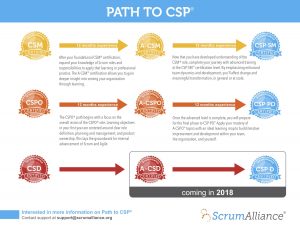“Path to CSP” – The A-CSM
December 21, 2017
Here are some key points about the A-CSM.
- The overall purpose is “learning to become more effective so that you can help the Team and your company be more successful” through lean-agile-scrum.
- If you have an A-CSM through me, I will be completely convinced that you are notably better than an average CSM. This ability level should be readily recognized in the marketplace. More importantly, it will mean that you can get a decent team really going.
- Does not affect current CSM and CSPO offerings.
- The first step toward a CSP-SM (Certified Scrum Professional).
- An annual progressive learning structure. That is the idea. Become CSM, get 12 months of good experience, take the course, become A-CSM, get 12 more months of good experience, take the course, become CSP-SM. That’s the simple version.
- The A-CSM is mostly explained here:
https://www.scrumalliance.org/certifications/advanced/a-csm - To get an A-CSM: (i) have a CSM, (ii) get 12 months of SM experience, (iii) be assessed by a CST/CEC as “good enough” on the A-CSM Learning Objectives. But (iii) can precede (ii).
- See FAQ here: https://scrumalliance.zendesk.com/hc/en-us/sections/115000453451-Advanced-CSM-
- Specifically, you have to demonstrate in the course (and partly before the course) that you can explain things and DO the things indicated in the Learning Objectives. This is a hard test. (There is no formal test as we usually know them.)
- The Learning Objectives are here: https://www.scrumalliance.org/ScrumRedesignDEVSite/media/ScrumAllianceMedia/Files%20and%20PDFs/Certifications/CSM/csm_learningobjectives_Advanced.pdf
- In my case, I will want to know that you can make change happen. And that you have learned some of the skill sets (aka Learning Objectives) that will make you better and better at making real change happen, in the context of Scrum. My Learning Objectives exceed the list from Scrum Alliance. But it is not too hard.
- You can take the course first and get the experience later. But no A-CSM without the experience as a SM in a Team. You could have gotten (some of) the experience before you took the CSM, in theory.
- You can get the experience in any combination of before or after the course. I strongly prefer that you have at least 3 months between your CSM and your A-CSM course.
- In my course, you must take the Agile Release Planning workshop (see any course description for details) and show high(er) proficiency. If you took the ARP workshop with my CSM course, you should be able to lead it fairly well by now or in some other way show higher proficiency.
- You can find my next A-CSM courses here: https://leanagiletraining.com/lean-agile-and-scrum-courses/
[See better version of this graphic here: Graphic_PathToCSP-1]
« « The Product Backlog || The Sprint Backlog » »

